1. Torre LA, Siegel RL, Jemal A. Lung cancer statistics. Adv Exp Med Biol. 2016; 893:1–19. PMID:
26667336.

2. Schiller JH, Harrington D, Belani CP, Langer C, Sandler A, Krook J, et al. Comparison of four chemotherapy regimens for advanced non-small-cell lung cancer. N Engl J Med. 2002; 346:92–98. PMID:
11784875.

3. Fossella F, Pereira JR, von Pawel J, Pluzanska A, Gorbounova V, Kaukel E, et al. Randomized, multinational, phase III study of docetaxel plus platinum combinations versus vinorelbine plus cisplatin for advanced non-small-cell lung cancer: the TAX 326 study group. J Clin Oncol. 2003; 21:3016–3024. PMID:
12837811.

4. Mok TS, Wu YL, Thongprasert S, Yang CH, Chu DT, Saijo N, et al. Gefitinib or carboplatin-paclitaxel in pulmonary adenocarcinoma. N Engl J Med. 2009; 361:947–957. PMID:
19692680.

5. Maemondo M, Inoue A, Kobayashi K, Sugawara S, Oizumi S, Isobe H, et al. Gefitinib or chemotherapy for non-small-cell lung cancer with mutated
EGFR. N Engl J Med. 2010; 362:2380–2388. PMID:
20573926.
6. Rosell R, Carcereny E, Gervais R, Vergnenegre A, Massuti B, Felip E, et al. Erlotinib versus standard chemotherapy as first-line treatment for European patients with advanced
EGFR mutation-positive non-small-cell lung cancer (EURTAC): a multicentre, open-label, randomised phase 3 trial. Lancet Oncol. 2012; 13:239–246. PMID:
22285168.
7. Hirsch FR, Bunn PA Jr. EGFR testing in lung cancer is ready for prime time. Lancet Oncol. 2009; 10:432–433. PMID:
19410185.

8. Laurie SA, Goss GD. Role of epidermal growth factor receptor inhibitors in epidermal growth factor receptor wild-type non-small-cell lung cancer. J Clin Oncol. 2013; 31:1061–1069. PMID:
23401452.

9. Wang F, Fu S, Shao Q, Zhou YB, Zhang X, Zhang X, et al. High
EGFR copy number predicts benefits from tyrosine kinase inhibitor treatment for non-small cell lung cancer patients with wild-type
EGFR. J Transl Med. 2013; 11:90. PMID:
23557218.

10. Hou MM, Huang SF, Kuo HP, Yang CT, Tsai YH, Yu CT, et al. Erlotinib treatment in patients with advanced lung adenocarcinoma with CISH-positive and CISH-negative
EGFR gene alterations. Anticancer Res. 2012; 32:1107–1112. PMID:
22399641.
11. Hirsch FR, Varella-Garcia M, McCoy J, West H, Xavier AC, Gumerlock P, et al. Increased epidermal growth factor receptor gene copy number detected by fluorescence
in situ hybridization associates with increased sensitivity to gefitinib in patients with bronchioloalveolar carcinoma subtypes: a Southwest Oncology Group Study. J Clin Oncol. 2005; 23:6838–6845. PMID:
15998906.
12. Cappuzzo F, Hirsch FR, Rossi E, Bartolini S, Ceresoli GL, Bemis L, et al. Epidermal growth factor receptor gene and protein and gefitinib sensitivity in non-small-cell lung cancer. J Natl Cancer Inst. 2005; 97:643–655. PMID:
15870435.

13. Olayioye MA, Neve RM, Lane HA, Hynes NE. The ErbB signaling network: receptor heterodimerization in development and cancer. EMBO J. 2000; 19:3159–3167. PMID:
10880430.
14. Varella-Garcia M, Diebold J, Eberhard DA, Geenen K, Hirschmann A, Kockx M, et al. EGFR fluorescence
in situ hybridisation assay: guidelines for application to non-small-cell lung cancer. J Clin Pathol. 2009; 62:970–977. PMID:
19861557.
15. Fritzsche FR, Bode PK, Moch H, Kristiansen G, Varga Z, Bode B. Determination of the Her-2/neu gene amplification status in cytologic breast cancer specimens using automated silver-enhanced
in-situ hybridization (SISH). Am J Surg Pathol. 2010; 34:1180–1185. PMID:
20661016.
16. Wulf MA, Bode B, Zimmermann D, Rufibach K, Weder W, Moch H, et al. Silver-enhanced
in situ hybridization for determination of
EGFR copy number alterations in non-small cell lung cancer. Am J Surg Pathol. 2012; 36:1801–1808. PMID:
23154768.
17. Gaiser T, Waha A, Moessler F, Bruckner T, Pietsch T, von Deimling A. Comparison of automated silver enhanced in situ hybridization and fluorescence
in situ hybridization for evaluation of epidermal growth factor receptor status in human glioblastomas. Mod Pathol. 2009; 22:1263–1271. PMID:
19525925.
18. Na II, Kang HJ, Cho SY, Koh JS, Lee JK, Lee BC, et al.
EGFR mutations and human papillomavirus in squamous cell carcinoma of tongue and tonsil. Eur J Cancer. 2007; 43:520–526. PMID:
17224267.
19. Boldrini L, Gisfredi S, Ursino S, Camacci T, Baldini E, Melfi F, et al. Mutational analysis in cytological specimens of advanced lung adenocarcinoma: a sensitive method for molecular diagnosis. J Thorac Oncol. 2007; 2:1086–1090. PMID:
18090579.

20. Na II, Park JH, Choe du H, Lee JK, Koh JS. Association of epidermal growth factor receptor mutations with metastatic presentations in non-small cell lung cancer. ISRN Oncol. 2011; 2011:756265. PMID:
22091430.

21. Han JY, Park K, Kim SW, Lee DH, Kim HY, Kim HT, et al. First-SIGNAL: first-line single-agent iressa versus gemcitabine and cisplatin trial in never-smokers with adenocarcinoma of the lung. J Clin Oncol. 2012; 30:1122–1128. PMID:
22370314.

22. Chang MH, Ahn HK, Lee J, Jung CK, Choi YL, Park YH, et al. Clinical impact of amphiregulin expression in patients with epidermal growth factor receptor (
EGFR) wild-type nonsmall cell lung cancer treated with EGFR-tyrosine kinase inhibitors. Cancer. 2011; 117:143–151. PMID:
20803614.
23. Dahabreh IJ, Linardou H, Kosmidis P, Bafaloukos D, Murray S.
EGFR gene copy number as a predictive biomarker for patients receiving tyrosine kinase inhibitor treatment: a systematic review and meta-analysis in non-small-cell lung cancer. Ann Oncol. 2011; 22:545–552. PMID:
20826716.
24. Lee Y, Shim HS, Park MS, Kim JH, Ha SJ, Kim SH, et al. High
EGFR gene copy number and skin rash as predictive markers for EGFR tyrosine kinase inhibitors in patients with advanced squamous cell lung carcinoma. Clin Cancer Res. 2012; 18:1760–1768. PMID:
22271877.
25. Li N, Ou W, Yang H, Liu QW, Zhang SL, Wang BX, et al. A randomized phase 2 trial of erlotinib versus pemetrexed as second-line therapy in the treatment of patients with advanced
EGFR wild-type and EGFR FISH-positive lung adenocarcinoma. Cancer. 2014; 120:1379–1386. PMID:
24481719.
26. Ren S, Su C, Wang Z, Li J, Fan L, Li B, et al. Epithelial phenotype as a predictive marker for response to EGFR-TKIs in non-small cell lung cancer patients with wild-type
EGFR. Int J Cancer. 2014; 135:2962–2971. PMID:
24771540.
27. Lai SW, Ho CL, Dai MS, Chen WL, Chang PY, Wu YY, et al. Gefitinib as first-line treatment for patients with epidermal growth factor receptor-mutated advanced lung adenocarcinoma: a single institution experience in Taiwan. J BUON. 2014; 19:459–465. PMID:
24965407.
28. Kaneda H, Tamura K, Kurata T, Uejima H, Nakagawa K, Fukuoka M. Retrospective analysis of the predictive factors associated with the response and survival benefit of gefitinib in patients with advanced non-small-cell lung cancer. Lung Cancer. 2004; 46:247–254. PMID:
15474673.

29. Yang CH, Shih JY, Chen KC, Yu CJ, Yang TY, Lin CP, et al. Survival outcome and predictors of gefitinib antitumor activity in East Asian chemonaive patients with advanced nonsmall cell lung cancer. Cancer. 2006; 107:1873–1882. PMID:
16989002.

30. Sanchez de Cos Escuin J, Abal Arca J, Melchor Iniguez R, Miravet Sorribes L, Nunez Ares A, Hernandez Hernandez JR, et al. Tumor, node and metastasis classification of lung cancer: M1a versus M1b: analysis of M descriptors and other prognostic factors. Lung Cancer. 2014; 84:182–189. PMID:
24629637.
31. Park S, Kim HJ, Choi CM, Lee DH, Kim SW, Lee JS, et al. Predictive factors for a long-term response duration in non-squamous cell lung cancer patients treated with pemetrexed. BMC Cancer. 2016; 16:417. PMID:
27388008.

32. Park JH, Kim TM, Keam B, Jeon YK, Lee SH, Kim DW, et al. Tumor burden is predictive of survival in patients with non-small-cell lung cancer and with activating epidermal growth factor receptor mutations who receive gefitinib. Clin Lung Cancer. 2013; 14:383–389. PMID:
23313171.

33. Oh Y, Taylor S, Bekele BN, Debnam JM, Allen PK, Suki D, et al. Number of metastatic sites is a strong predictor of survival in patients with nonsmall cell lung cancer with or without brain metastases. Cancer. 2009; 115:2930–2938. PMID:
19441110.

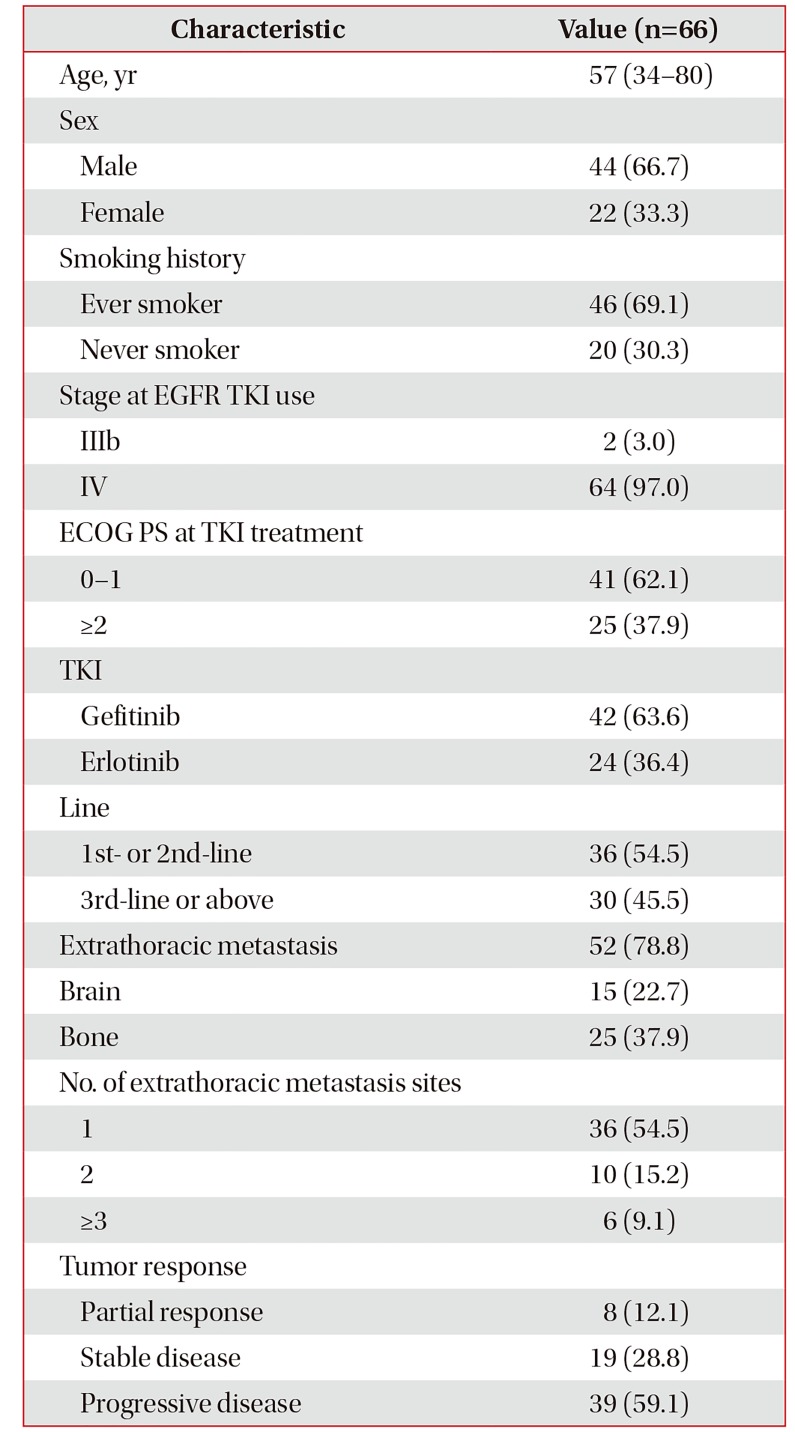
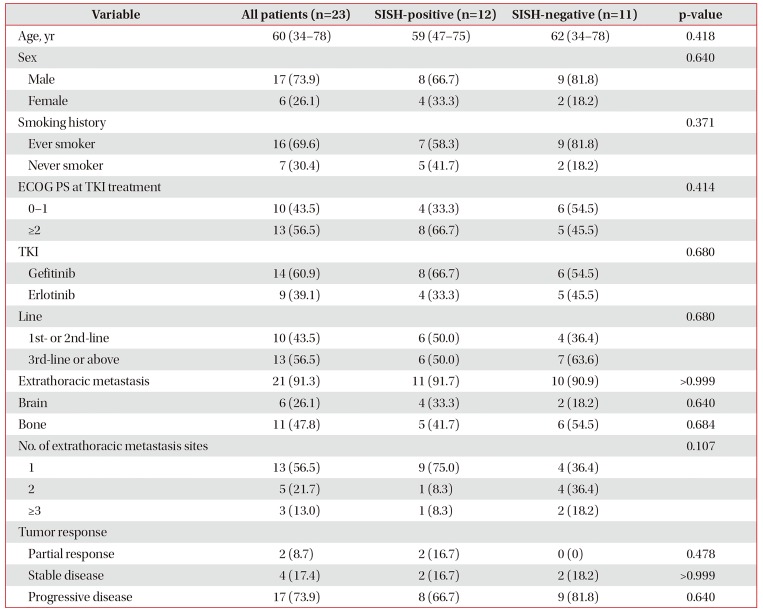
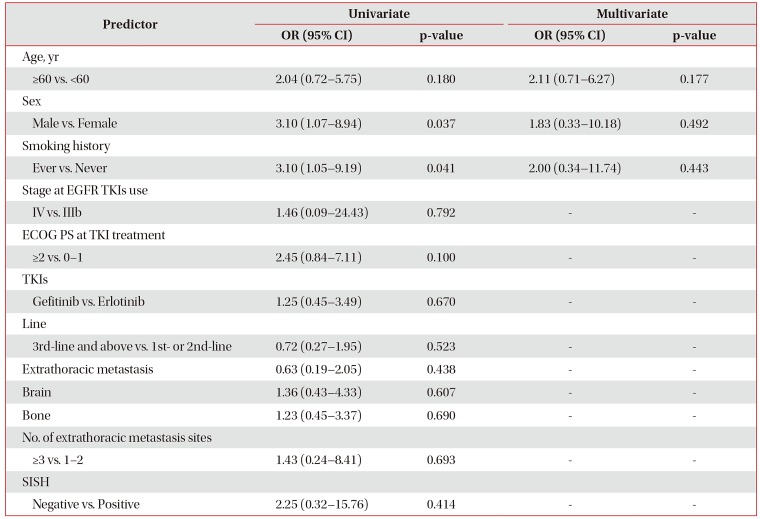
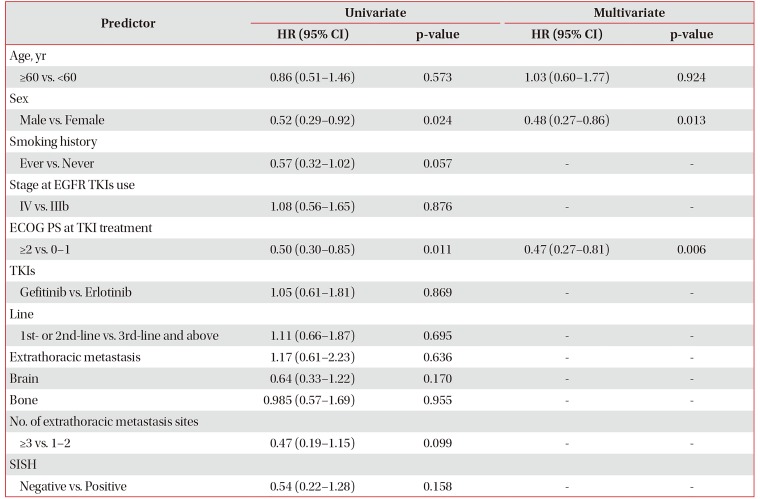
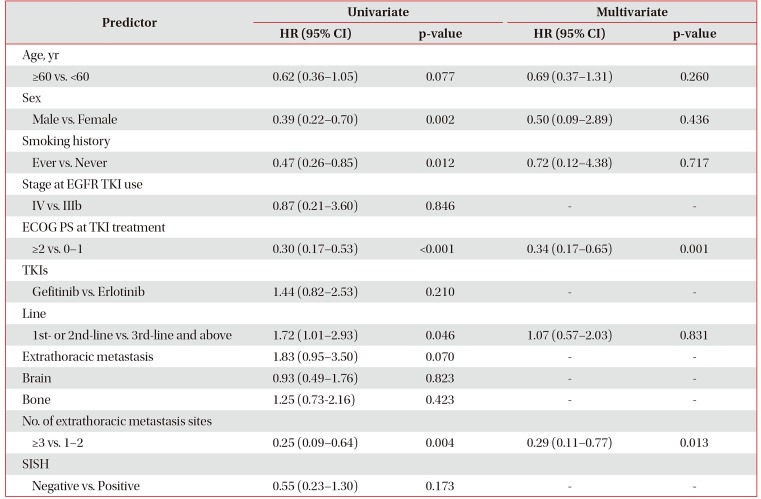




 PDF
PDF ePub
ePub Citation
Citation Print
Print



 XML Download
XML Download